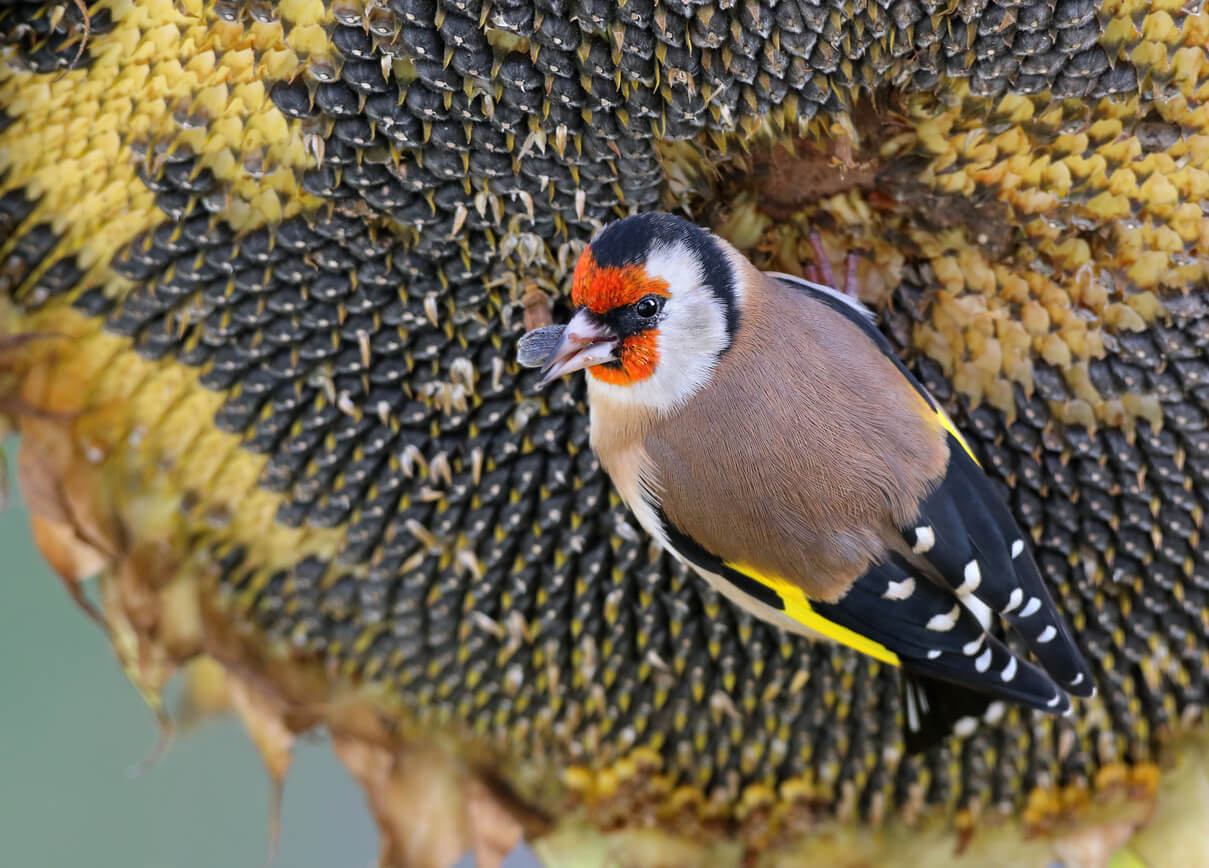
Sunflower head invaded and eaten by aphids
You may find aphids, caterpillars, Japanese beetles, thrips, leafhoppers, borers, and the sunflower fruit fly on your sunflower plants.
Here’s what to look for to spot damage from these pests.
| Symptom | Pest |
|---|---|
| Yellowing leaves; clusters of “honeydew” or small “bumps” on underside of leaves; curled leaves | Aphids |
| Stems cut off at soil level | Cutworm |
| Holes or transparent “windows” in the leaves | Sunflower beetles |
| Heavy damage to leaf and flower stems | Weevils |
| Plants turns yellow and wilts | Wireworms, Darkling beetles |
| Irregularly shaped holes in leaves; webbing | Thistle caterpillars |
| Large areas of tree encased by webbing; heavy leaf damage | Tent caterpillars |
| Symptom | Pest |
|---|---|
| Dark spots and webbing on the flowers | Sunflower moths |
| Low seed production; gnarled flower heads | Sunflower midges |
| Missing flower heads | Squirrels |
| Seeds missing from flower head | Squirrels, birds |
How to treat pests on sunflower plants
Here are some proven ways to get rid of pests on your sunflower plants. Choose the best treatment for the type of pests invading your plants.
- Pick off the pests. Use your garden gloves to remove the pests by hand. After removal, destroy pests by drowning them in a bucket of soapy water or crushing them with your foot. Handpicking isn’t efficient or practical for very small pests but works well with larger pests.
- Apply Diatomaceous Earth (DE). Soft-bodies pests like cutworms and the larvae of other insects don’t stand a chance if you lay down a layer of diatomaceous earth. The tiny jagged edges of this superfine powder act like tiny razor blades and also dry up the mucous membranes of pests.
- Use beneficial nematodes. These microscopic organisms will hunt down and destroy insect larvae living and feeding in the soil. The species Steinernema carpocapsae helps control wireworms; the species Heterorhabditis bacteriophora helps control weevils.
- Apply insecticidal soap. Insecticidal soap is organic. The potassium salts in insecticidal soap help remove an insect’s protective waxes, causing destruction of insect membranes and killing them. Mix the soap with water to create your solution, and apply directly to insects on any plants. While insecticidal soap is less apt to affect other organisms, certain plants might be sensitive to the soap and can suffer leaf burn.
- Apply horticultural oils. Combine plant- or petroleum-based oils with water to produce horticultural sprays. Neem oil, for instance, is derived from seed extracts of the neem plant. Oil-based sprays block an insect’s air holes, interfere with an insect’s metabolism, disrupt insect feeding, and inhibit insect growth. Like insecticidal soaps, horticultural oils can cause plant injury if not properly diluted.
- Make your own pest spray. You can make your own pest spray with benign materials. Mix one tablespoon of baking soda, 1/2 teaspoon of a mild dish detergent, and 2 1/2 tablespoons of olive oil in a gallon of water to make a solution that will repel all kinds of bugs, as well as a fungicide for mildew that may show up on your sunflower leaves. Shake it well in your bottle before spraying and repeat every week for it to be continuously effective.
A word about birds

Goldfinch eating sunflower seeds from a sunflower
Birds can be a major issue with your sunflowers. You can deter birds by draping bird netting, cheesecloth, or loosely-tied paper bags with small holes for ventilation over the flower heads as they reach maturity. Not attractive, but effective.
Bird netting can protect your sunflowers from birds and squirrels—but it can also trap and kill birds and squirrels. So you may want to consider similarly protective but less lethal defense for your sunflowers, like cheesecloth and paper bags.
Other repelling/distracting tactics:
- Tie reflective tape to stems to distract and disorient birds.
- Use a dummy owl/hawk and move its location daily.
- Eliminate insects on the plants to deter birds.
- Install a birdhouse to attract the predatory kestrel.
- Plant wildflowers like echinacea and rudbeckia to give birds an easier meal.
No single method works better than the others, so you should probably try swapping preventive measures or using more than one at a time to keep the birds from your sunflowers.
Deer
Deer love a good snack, and a bright, growing sunflower or its fresh green leaves may just hit the spot. Now, there’s not always a lot you can do to deter a determined deer; you may need fencing around your sunflowers just as you might around the rest of your garden bed. If you do install fencing, you want it to be about 8 feet high; remember, a determined, hungry deer standing on its hind legs can have quite a reach. There are also a few plants that deer don’t find especially tasty: lavender, columbine, yarrow, ornamental onion, and heliotrope are good deer deterrent choices.
Do pests attack your sunflower plants every year? How do you handle removing them—and even preventing them in the first place? Please tell us how you treat your sunflower plants to avoid pests.


 Previous
Previous

